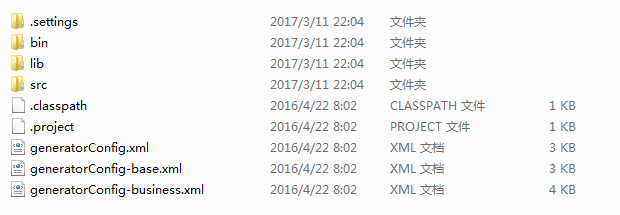【Mybatis】深入淺出Mybatis(十)——逆向工程
一、前言
前一篇部落格中,小編向大家介紹了一下Mybatis和hibernate的對比,在這一篇部落格說說mybatis的逆向工程,展示一下,一個非常讓你驚訝的技術,只要你有一個數據庫,你的持久層,你的D層從此不用你自己手寫了。
二、什麼是逆向工程?
mybaits需要程式設計師自己編寫sql語句,mybatis官方提供逆向工程 可以針對單表自動生成mybatis執行所需要的程式碼(mapper.java,mapper.xml、po..),企業實際開發中,常用的逆向工程方式:由於資料庫的表生成java程式碼。
三、Mybatis中逆向工程的使用
3.1 前期準備



3.2 匯入
- 匯入已有的資料庫,小編已經匯入自己編寫好的資料庫,資料庫結構如下:

- 把generatorSqlmapCustom JavaProject匯入eclipse

3.3 需要修改的檔案
先要查詢資料庫配置檔案是哪一個,在GeneratorSqlmap.java中可以查詢到。

- 修改配置檔案的資料庫連線以及資料庫

- 指定資料庫表
<!-- 指定資料庫表 -->
<table - 生成表對應的實體類
<!-- targetProject:生成PO類的位置 -->
<javaModelGenerator targetPackage - mapper對映檔案生成
<!-- targetProject:mapper對映檔案生成的位置 -->
<sqlMapGenerator targetPackage="cn.itcast.ssm.mapper"
targetProject=".\src">
<!-- enableSubPackages:是否讓schema作為包的字尾 -->
<property name="enableSubPackages" value="false" />
</sqlMapGenerator>- mapper介面生成
<!-- targetPackage:mapper介面生成的位置 -->
<javaClientGenerator type="XMLMAPPER"
targetPackage="cn.itcast.ssm.mapper" targetProject=".\src">
<!-- enableSubPackages:是否讓schema作為包的字尾 -->
<property name="enableSubPackages" value="false" />
</javaClientGenerator>- 幾個關鍵屬性:
javaModelGenerator :實體類生成;
sqlMapGenerator :對映檔案生成;
javaClientGenerator :介面生成;
targetProject:生成檔案的位置,本例中.\src,是指src下的目錄;
targetPackage:生成包的名稱;
修改完成後,執行GeneratorSqlmap.java中的main方法,就可以生成。
3.4 生成檔案展示
巨集觀展示:

以User表為例,展示生成的程式碼:
- User.java
package cn.itcast.ssm.po;
import java.util.Date;
public class User {
private Integer id;
private String username;
private Date birthday;
private String sex;
private String address;
public Integer getId() {
return id;
}
public void setId(Integer id) {
this.id = id;
}
public String getUsername() {
return username;
}
public void setUsername(String username) {
this.username = username == null ? null : username.trim();
}
public Date getBirthday() {
return birthday;
}
public void setBirthday(Date birthday) {
this.birthday = birthday;
}
public String getSex() {
return sex;
}
public void setSex(String sex) {
this.sex = sex == null ? null : sex.trim();
}
public String getAddress() {
return address;
}
public void setAddress(String address) {
this.address = address == null ? null : address.trim();
}
}- UserMapper.java
這裡生成了所有的增刪改查的sql語句,呼叫的時候就直接使用對應的方法就可以了。很方便吧。(這裡可以重點學習一下,看自動生成的程式碼是如何封裝的,自己要認真學習一下哦)
package cn.itcast.ssm.mapper;
import cn.itcast.ssm.po.User;
import cn.itcast.ssm.po.UserExample;
import java.util.List;
import org.apache.ibatis.annotations.Param;
public interface UserMapper {
int countByExample(UserExample example);
int deleteByExample(UserExample example);
int deleteByPrimaryKey(Integer id);
int insert(User record);
int insertSelective(User record);
List<User> selectByExample(UserExample example);
User selectByPrimaryKey(Integer id);
int updateByExampleSelective(@Param("record") User record, @Param("example") UserExample example);
int updateByExample(@Param("record") User record, @Param("example") UserExample example);
int updateByPrimaryKeySelective(User record);
int updateByPrimaryKey(User record);
}- UserMapper.xml
<?xml version="1.0" encoding="UTF-8" ?>
<!DOCTYPE mapper PUBLIC "-//mybatis.org//DTD Mapper 3.0//EN" "http://mybatis.org/dtd/mybatis-3-mapper.dtd" >
<mapper namespace="cn.itcast.ssm.mapper.UserMapper" >
<resultMap id="BaseResultMap" type="cn.itcast.ssm.po.User" >
<id column="id" property="id" jdbcType="INTEGER" />
<result column="username" property="username" jdbcType="VARCHAR" />
<result column="birthday" property="birthday" jdbcType="DATE" />
<result column="sex" property="sex" jdbcType="CHAR" />
<result column="address" property="address" jdbcType="VARCHAR" />
</resultMap>
<sql id="Example_Where_Clause" >
<where >
<foreach collection="oredCriteria" item="criteria" separator="or" >
<if test="criteria.valid" >
<trim prefix="(" suffix=")" prefixOverrides="and" >
<foreach collection="criteria.criteria" item="criterion" >
<choose >
<when test="criterion.noValue" >
and ${criterion.condition}
</when>
<when test="criterion.singleValue" >
and ${criterion.condition} #{criterion.value}
</when>
<when test="criterion.betweenValue" >
and ${criterion.condition} #{criterion.value} and #{criterion.secondValue}
</when>
<when test="criterion.listValue" >
and ${criterion.condition}
<foreach collection="criterion.value" item="listItem" open="(" close=")" separator="," >
#{listItem}
</foreach>
</when>
</choose>
</foreach>
</trim>
</if>
</foreach>
</where>
</sql>
<sql id="Update_By_Example_Where_Clause" >
<where >
<foreach collection="example.oredCriteria" item="criteria" separator="or" >
<if test="criteria.valid" >
<trim prefix="(" suffix=")" prefixOverrides="and" >
<foreach collection="criteria.criteria" item="criterion" >
<choose >
<when test="criterion.noValue" >
and ${criterion.condition}
</when>
<when test="criterion.singleValue" >
and ${criterion.condition} #{criterion.value}
</when>
<when test="criterion.betweenValue" >
and ${criterion.condition} #{criterion.value} and #{criterion.secondValue}
</when>
<when test="criterion.listValue" >
and ${criterion.condition}
<foreach collection="criterion.value" item="listItem" open="(" close=")" separator="," >
#{listItem}
</foreach>
</when>
</choose>
</foreach>
</trim>
</if>
</foreach>
</where>
</sql>
<sql id="Base_Column_List" >
id, username, birthday, sex, address
</sql>
<select id="selectByExample" resultMap="BaseResultMap" parameterType="cn.itcast.ssm.po.UserExample" >
select
<if test="distinct" >
distinct
</if>
<include refid="Base_Column_List" />
from user
<if test="_parameter != null" >
<include refid="Example_Where_Clause" />
</if>
<if test="orderByClause != null" >
order by ${orderByClause}
</if>
</select>
<select id="selectByPrimaryKey" resultMap="BaseResultMap" parameterType="java.lang.Integer" >
select
<include refid="Base_Column_List" />
from user
where id = #{id,jdbcType=INTEGER}
</select>
<delete id="deleteByPrimaryKey" parameterType="java.lang.Integer" >
delete from user
where id = #{id,jdbcType=INTEGER}
</delete>
<delete id="deleteByExample" parameterType="cn.itcast.ssm.po.UserExample" >
delete from user
<if test="_parameter != null" >
<include refid="Example_Where_Clause" />
</if>
</delete>
<insert id="insert" parameterType="cn.itcast.ssm.po.User" >
insert into user (id, username, birthday,
sex, address)
values (#{id,jdbcType=INTEGER}, #{username,jdbcType=VARCHAR}, #{birthday,jdbcType=DATE},
#{sex,jdbcType=CHAR}, #{address,jdbcType=VARCHAR})
</insert>
<insert id="insertSelective" parameterType="cn.itcast.ssm.po.User" >
insert into user
<trim prefix="(" suffix=")" suffixOverrides="," >
<if test="id != null" >
id,
</if>
<if test="username != null" >
username,
</if>
<if test="birthday != null" >
birthday,
</if>
<if test="sex != null" >
sex,
</if>
<if test="address != null" >
address,
</if>
</trim>
<trim prefix="values (" suffix=")" suffixOverrides="," >
<if test="id != null" >
#{id,jdbcType=INTEGER},
</if>
<if test="username != null" >
#{username,jdbcType=VARCHAR},
</if>
<if test="birthday != null" >
#{birthday,jdbcType=DATE},
</if>
<if test="sex != null" >
#{sex,jdbcType=CHAR},
</if>
<if test="address != null" >
#{address,jdbcType=VARCHAR},
</if>
</trim>
</insert>
<select id="countByExample" parameterType="cn.itcast.ssm.po.UserExample" resultType="java.lang.Integer" >
select count(*) from user
<if test="_parameter != null" >
<include refid="Example_Where_Clause" />
</if>
</select>
<update id="updateByExampleSelective" parameterType="map" >
update user
<set >
<if test="record.id != null" >
id = #{record.id,jdbcType=INTEGER},
</if>
<if test="record.username != null" >
username = #{record.username,jdbcType=VARCHAR},
</if>
<if test="record.birthday != null" >
birthday = #{record.birthday,jdbcType=DATE},
</if>
<if test="record.sex != null" >
sex = #{record.sex,jdbcType=CHAR},
</if>
<if test="record.address != null" >
address = #{record.address,jdbcType=VARCHAR},
</if>
</set>
<if test="_parameter != null" >
<include refid="Update_By_Example_Where_Clause" />
</if>
</update>
<update id="updateByExample" parameterType="map" >
update user
set id = #{record.id,jdbcType=INTEGER},
username = #{record.username,jdbcType=VARCHAR},
birthday = #{record.birthday,jdbcType=DATE},
sex = #{record.sex,jdbcType=CHAR},
address = #{record.address,jdbcType=VARCHAR}
<if test="_parameter != null" >
<include refid="Update_By_Example_Where_Clause" />
</if>
</update>
<update id="updateByPrimaryKeySelective" parameterType="cn.itcast.ssm.po.User" >
update user
<set >
<if test="username != null" >
username = #{username,jdbcType=VARCHAR},
</if>
<if test="birthday != null" >
birthday = #{birthday,jdbcType=DATE},
</if>
<if test="sex != null" >
sex = #{sex,jdbcType=CHAR},
</if>
<if test="address != null" >
address = #{address,jdbcType=VARCHAR},
</if>
</set>
where id = #{id,jdbcType=INTEGER}
</update>
<update id="updateByPrimaryKey" parameterType="cn.itcast.ssm.po.User" >
update user
set username = #{username,jdbcType=VARCHAR},
birthday = #{birthday,jdbcType=DATE},
sex = #{sex,jdbcType=CHAR},
address = #{address,jdbcType=VARCHAR}
where id = #{id,jdbcType=INTEGER}
</update>
</mapper>四、小結
逆向工程在很多軟體裡面都有,比如EA的逆向工程,PB的逆向工程。還有很多,總之,這個就是其中的一些很有價值的東西,在企業運用的時候很方便,而且這些生成好的類,儘量不要去修改,如果非要修改的話,可以用pv類來實現繼承拓展。這是很好的選擇。
下一篇將向大家帶來Mybatis和Spring的結合。
